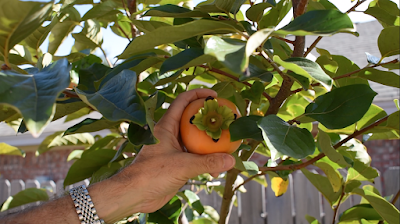Fuyukaki!
Description/Taste
The Fuyu persimmon is a non-astringent variety that benefits from a trifecta of qualities; it lacks a core, seeds, and tannins. Fuyu persimmons have a squat and rounded shape and are capped with an indented leaf. Fuyu persimmons boast an orange pumpkin color on both their skin and flesh. When ripe, Fuyu persimmons possess layers of flavor, reminiscent of pear, dates, and brown sugar with nuances of cinnamon. Their texture varies from crisp and succulent when young, to a tender and gelatinous texture as they mature. Fruits are ready for harvest when skins are deep orange, and unlike most other persimmon types, have no astringency and are ready to eat when still firm.
Seasons/Availability
Fuyu persimmons are available from mid-fall through the winter months.
Current Facts
Fuyu persimmons, botanically known as part of Diospyros kaki, are an Asian variety of persimmon. Persimmons are divided into two types, astringent and non-astringent. Fuyu persimmons are the leading non-astringent persimmon on the market and are the most widely cultivated persimmon in the world. Their non-astringency allows for them to be eaten fresh out of hand at various times during maturation. Astringent persimmons, which require being fully ripened prior to eating, are too fragile for shipping, lowering the commercial value of the fruit within a globally distributed food culture.
Nutritional Value
Fuyu persimmons contain significant amounts of fiber and vitamin A. Additionally they contain vitamin C and trace amounts of vitamin E, K, and B-6.
Applications
Fuyu persimmons are highly versatile as they can be eaten fresh out of hand, added raw to cold dishes, or added to cooked applications like roasts, sauces, jams, and jellies. They can be sliced and used as a topping for pizza, pies, tarts, yogurt, and toast. Cooked down and pureed, Fuyu can be used to make persimmon cakes, bread, puddings, ice cream, and pie filling. Complimentary flavors include ginger, vanilla, nutmeg, cream, brown sugar, and maple. Fuyu persimmons pair well with soft, fresh cheeses such as mozzarella and mascarpone, cranberries, pomegranates, pecans, pistachios, bacon, prosciutto, figs, mild lettuces, and bitter greens. Other compatible flavors are herbs, such as basil, arugula, and mint, along with citrus, balsamic vinegar, and nut oils like hazelnut and walnut. Fuyu persimmons can be kept at room temperature, but if preferred, can be refrigerated. Do not to store persimmons near apples or other ethylene-producing fruits as they are ethylene sensitive and will ripen and spoil quickly when exposed.
Ethnic/Cultural Info
When in season the persimmon is a prized fruit in many parts of the world. In Greek, the Fuyu persimmon’s botanical name, Diospyros means “divine fruit”. In Japan, persimmons are considered to be the country’s national fruit whereas the Fuyu is also known as Fuyukaki. Nationally in the United States, the Fuyu persimmon makes up nearly eighty percent of the persimmon market.
Geography/History
Persimmons have been cultivated for over a millennium in Asian countries, where they have long been an important fruit crop. Asian-type persimmons, such as the Fuyu, were first introduced to the United States in 1856 by Commander M.C. Perry. Commander Perry brought the seeds back from an American naval fleet visit to Japan, unfortunately, none of the seeds planted upon the return made it to maturity. Soon after this first attempt, the U.S. Department of Agriculture imported seeds from a variety of different Asian persimmons, including the Fuyu, from Asia. Since that time, many different types of Fuyu have been developed for disease resistance, hardiness, and flavor, helping to make the Fuyu the most highly cultivated and commercially successful persimmon type today. China produces upwards of three million tons annually of persimmons and is the leader in worldwide production. In the United States, the Fuyu persimmon is grown predominately in California, specifically in the central San Joaquin Valley, as well as in San Diego, Riverside, and Orange County. It is doing well here in Central Texas in our experience!




No comments:
Post a Comment